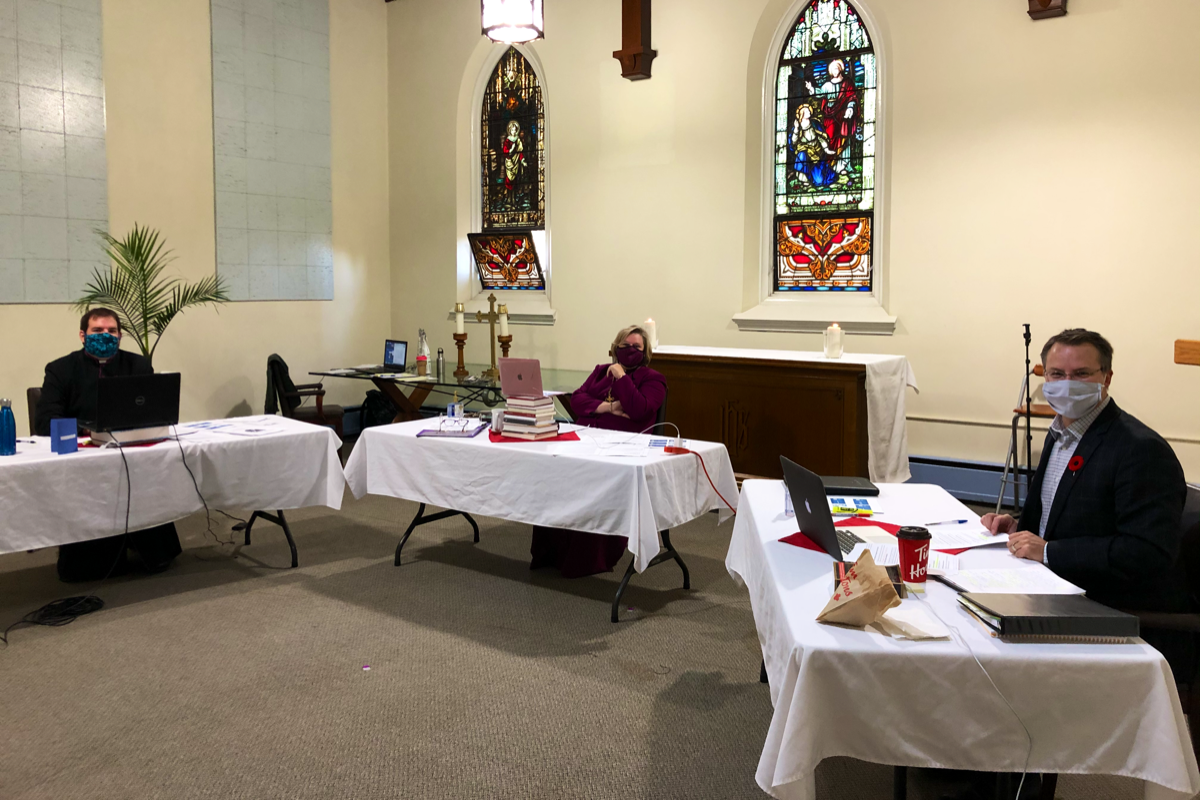“Enlighten the eyes of our hearts,” was the response to the opening prayers of the 146th synod of the diocese of Niagara which, in a historic first, convened virtually via Zoom videoconferencing on November 7.
Inspired by the synod theme and drawn from a passage in the Letter to the Ephesians, this prayer was enacted throughout the synod’s agenda. Through worship and stories, actions, elections and appointments, the synod offered members plenty of uplifting, inspiring and hope-filled moments of the Spirit’s work in and through the people and parishes of the diocese throughout the pandemic.

Synod convened with a territorial acknowledgement given by Cheryl Barker from the banks of the Grand River, the traditional territory of the Haudenosaunee, the Mississauga’s of the Credit, and the Neutrals. This was followed by a teaching on reconciliation offered by Archdeacon Valerie Kerr. “It starts with developing understanding and building relationships,” she observed and said reconciliation” continues with learning more about each other and respecting our differences.”
Mission Action Plan
Canon Christyn Perkons provided synod with an update about the diocesan Mission Action Plan (MAP), which identifies our active seeking of God and God’s mission and lays out diocesan priorities for the next three to five years. The presentation began by highlighting the ways last year’s synod impacted the final version of the MAP, noting the mission statement now includes trinitarian language.
While the pandemic has forced a pivot, Canon Perkons reported that much work in underway on the MAP’s three primary objectives.
The first objective is to discern and implement opportunities to ignite and strengthen faith and we partnered with God in many ways around faith strengthening and igniting. The launch of a new diocesan online service, the hiring of a Revive coordinator and diocesan missioner, a renewed relationship with Cursillo, and the development of the Anglican Family Hub, with all its many initiatives, were offered as a few of the examples of this objective being put into action.
Reimagining our diocesan culture and adapting our structures to enable ministry is the second objective of the MAP. “The reality is that for the last 10 months, we have all been constantly reimagining who we are and how we are called to live faithfully into the reality of the present,” said Canon Perkons. She also noted that a diocesan anti-racism working group has been formed, work is underway on the development of a school for missional leadership, and the ordination discernment process has been revamped.
With regards to prioritizing social justice action with an emphasis on environmental action, the third objective, Canon Perkons pointed towards the new mandate of the Climate Justice Niagara committee as well as plans for the formation of a human trafficking working group.
Canon Perkons also noted that a new easy to use, three-session, online-friendly resource will soon be available for parishes to develop their own mission action plan. Members of synod were also invited to provide feedback about the MAP to help in the work of continuing to contextualize this living plan.
Canon Changes
Three changes to our diocesan canons were considered and approved by members of synod. The most substantial change was the addition of a new canon about the cathedral of the diocese which regularizes the de facto situation which currently exists with respect to the administration of Cathedral Place by defining the special nature of the cathedral congregation’s status and ministry context. Drafted with the support of the cathedral corporation, the new canon enhances transparency and accountability, improves governance, and puts in place structures to better manage Cathedral Place.
Two other amendments to existing canons were approved. The first grants the Bishop the authority to call a meeting of synod council, in extraordinary circumstances, sooner than the usual 14-day notice period, enhancing the nimbleness of our governance structures to respond in a timely manner. The second creates the jurisdiction for the bishop and synod council to enact regulations related to the manner by which vestry meetings are conducted for situations which are not currently contemplated by the existing canons, such as virtual vestry meetings.
Budget
Acknowledging that “this is a difficult and extraordinary time” given the pandemic’s effects, Budget Chair Gerry Anthony presented a 3.6 million dollar diocesan budget. He noted that in recent years, the diocese has stewarded its resources wisely and as a result “we are heading into the next year is a relatively good position, all things considered.”
While the budget forecasts a deficit of $473,000, funds are in place to cover the deficit through the standard draw on investments and the sale of property in 2020.
The budget seeks to “balance fiscal responsibility with the need to carry on the essential work of the Church; to trim discretionary expenses and support parishes; and to live into our new vision for ministry while recognizing the evolving missional landscape,’ Anthony told members of synod.
Archdeacon Bill Mous outlined several initiatives included in the budget to support parishes, included the provision of $250,000 to support parishes who may not be able to meet their usual DM&M contributions, in spite of their best efforts to do so; $30,000 for a parish technology grant program; and the elimination of interest on receivables to support parish cash flow needs.
Treasurer Jody Beck walked members of synod through the more significant changes to the 2021 budget. She noted that employment expense will decline and that there will not be a cost of living increase included in the budget. Expenses have been reduced in many areas, given travel and in-person programs are expected to be significantly limited in 2021. A targeted stewardship campaign is also planned, recognizing that there are generous donors who want to help the diocese through this extraordinary time.
After a time for questions, the budget was overwhelmingly approved by synod.
Election Results
Using an electronic voting platform, members of synod elected representatives to the provincial synod planned for the fall of 2021. In the order of clergy, David Anderson, Valerie Kerr, Ann Turner, and Rod McDowell were elected. In the order of clergy, Andrew Clinkard, Janice Whiteley, Jodey Porter and Donna Ellis were elected. Rob Towler and Dan Bennett will serve as alternates for the clergy while Neil Bell and Rob Pawson will serve as alternates for the laity.
Synod also elected the following members to fill vacancies in the roles of regional representatives to synod council: Gary Pollard (Brock), Byran Elliston (Greater Wellington), David Eccles (Hamilton-Haldimand), and Byron Nicholson (Lincoln).
Fran Wallace and Sue-Ann Ward (clergy) as well as Sister Heather Broadwell (lay) we also elected as diocesan representatives to the Corporation of Trinity College for a term of two years.
Safe Church Policy Revision
Archdeacon Bill Mous gave an update work that is underway to overhaul of our existing policies with a more modern and robust Safe Church Policy. The revision will broaden our policies to include conflict, harassment, and discrimination, with a view towards incorporating our beliefs and values as Anglicans as expressed in the Anglican Communion Charter for the Safety of People, as well as current best practices and legislative requirements. The revised policy is expected to be brought forward for approval by synod council sometime in 2021.


Euchre and the Meaning of Life